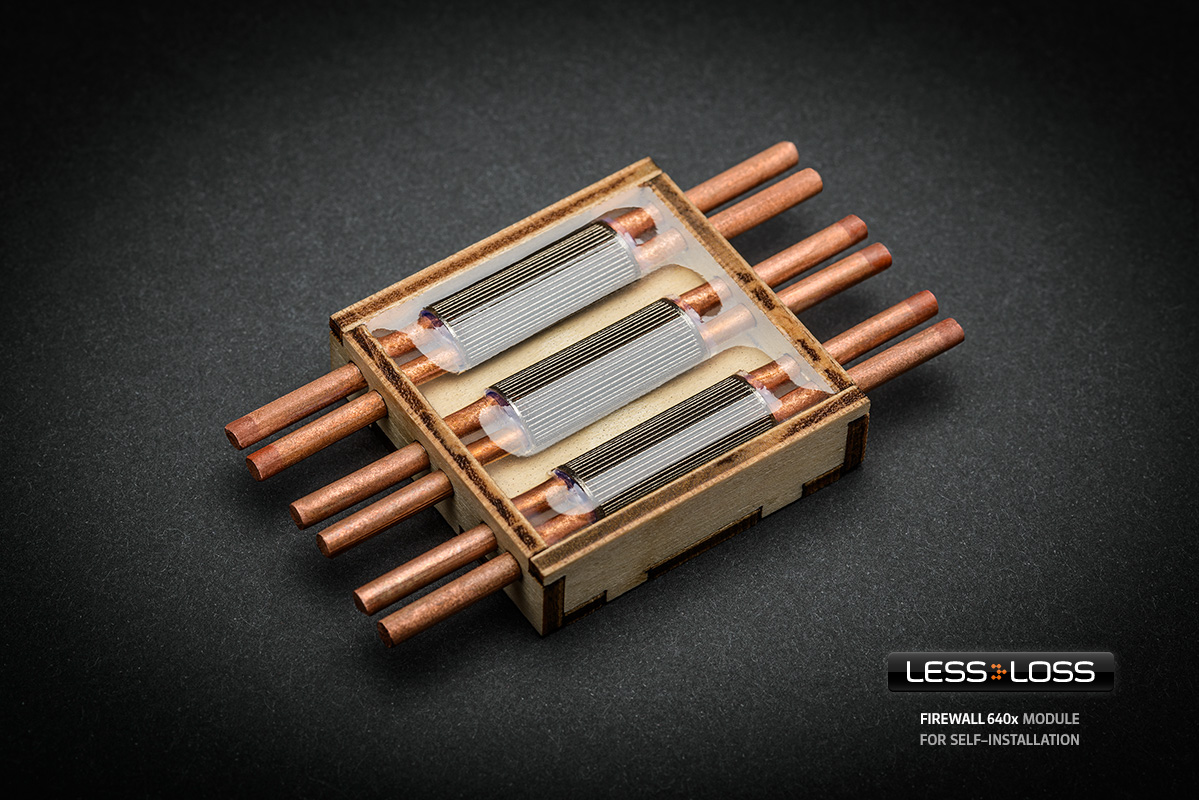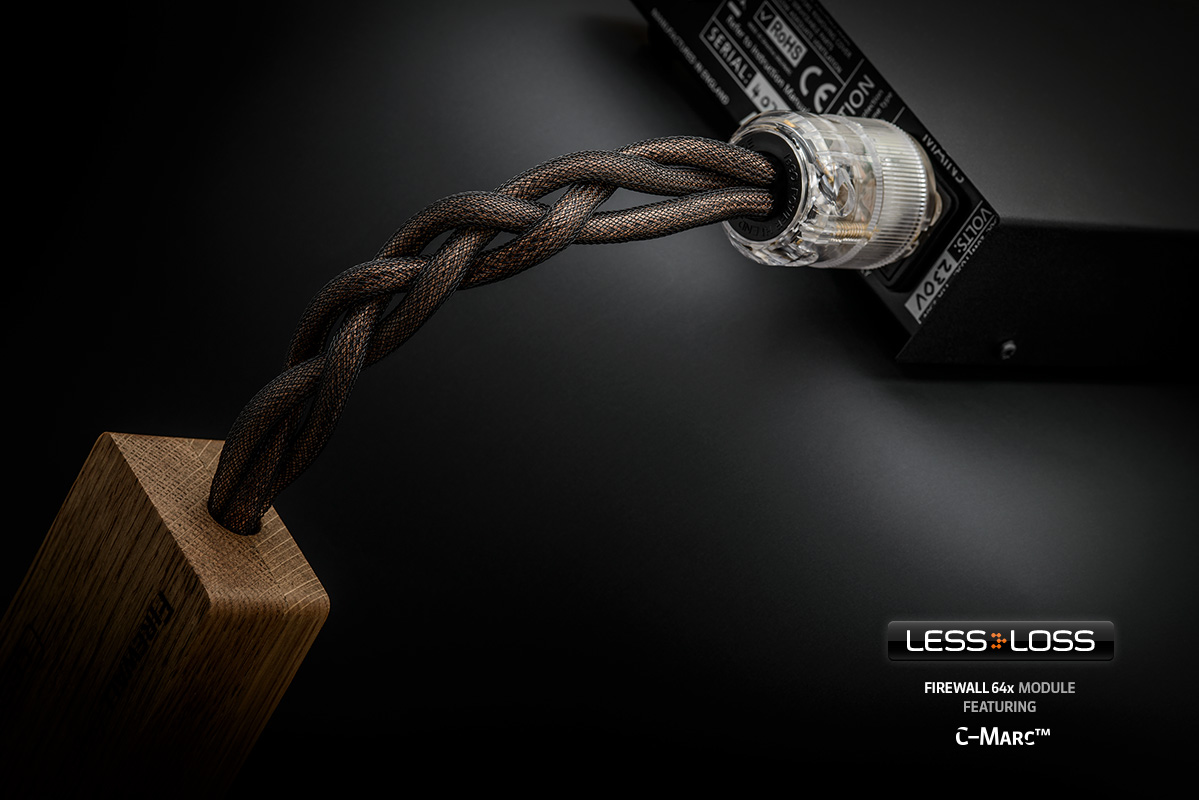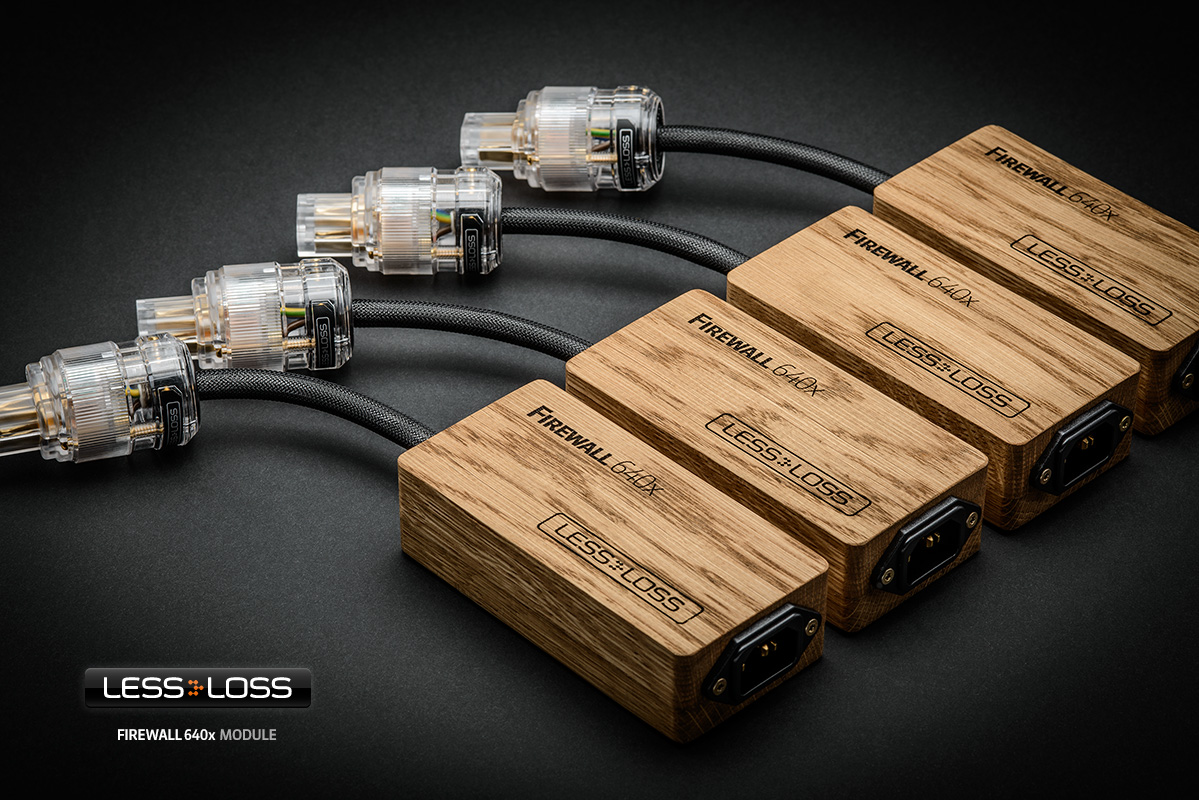Back in November of last year, our Ken Redmond reviewed the LessLoss Firewall 640x and 640x C-MARC and hailed it a seminal piece of audio gear, calling it a “waypoint” product and chose to add the 640x C-MARC to his system. As I was reading his impressions, I honestly kept thinking to myself, this can’t be real, this has to be hogwash. It isn’t that I don’t trust Ken, I do, I just didn’t, and frankly still don’t fully, understand how the Firewall works. Thus, I arranged to hear it for myself.
I connected with Louis Motek, the managing director of LessLoss, and we arranged to send over both versions of the Firewall 640x. The regular 640x arrived from Ken a month or so before the 640x C-MARC.
The Technology
I don’t want to do a deep rehash of the Firewall specs and technology, but suffice to say, the goal of the Firewall is to attenuate high frequencies in the electrical path that result in distortions to the final audio frequency range. The Firewall is created through a 3D laser-printed technology called Direct Metal Laser Sintering (DMLS) and DMLS is used the world over in complex metal printing for aerospace and medical products. The Firewall is a custom creation from LessLess that uses a proprietary design to attenuate high frequencies on the skin of a wire and is made from a custom alloy along with copper wires that have undergone LessLoss’s trademarked Entropic process. The 640x uses the less expensive power cord, and the 640x C-MARC uses the C-MARC power cord.
Further reading can be found on the LessLoss website. As well as an interesting post on the development and prototypes of their products.
It should also be noted that LessLoss sells a version of the Firewall for DIY projects. That is pictured below.

Initial Setup
It was suggested to Ken to plug the Firewall in before everything else, so I started with the regular Firewall 640x between my Audience forte V8 power strip and the Audience forte F3 power cord that is plugged into the wall outlet. This provides power to a Raspberry PI running Volumio 3 and the Schitt multibit Gungnir DAC. According to LessLoss, ideally, the Firewall should come before everything else. But unlike Ken’s setup, I prefer my amplifiers to be plugged right into the wall outlet. The Audience forte V8 seems to be better suited for electronics than the amplifier. Initially, when I just had the one 640x version, I let the Firewall just work on the power for the music server and DAC.
As I was on a headphone kick at the time, and I was still building a new set of Voight Pipe cabinets, I ended up doing all my initial listening with my older set of Audeze LCD-2 headphones or a borrowed set of ZMF Aeolus headphones. Both used an Audio Note silver Litz headphone cable plugged into the headphone jack of the Rogers High Fidelity 65V-2 amplifier or Burson HA-1 headphone amplifier.
Well, whatever is inside the small wooden box of the Firewall, and however it really works, it does make a difference.
It was immediately apparent and easy to pick out the sonic impact of the Firewall. The very top-end, as well as transients, were exceptionally clearer and with a slight bit more volume to them. This resulted in the sound stage being more apparent and everything at the cymbal frequency range, or other high frequencies, being exceptionally clearer and much easier to understand. The mid-range, as well as the bass, also sounded cleaner, which could be due to a better cohesion of the transients to the rest of the music, or just less distortion overall.
As Ken suggests, it is as if yet another small layer of the obfuscating film had been removed from the recording.
I also noted the tail-end of the drum strikes or last vocals on a track, whenever a sound was given time to completely decay, was clearer. The slope of the decaying sound was more sustained and natural sounding, and the lower level tail-end of the sound was easier to hear. Plus, when the decaying sound finally faded so low as to no longer hear it, it did so with just a bit more presence in that final transition from life to death.
During the music, the high level of detail in the decay was also more noticeable, giving what seems like more “space” between the notes of the music or the vocalizations of the singer. For example, Lenard Cohen’s lips smacks were a bit more discernible and his voice, on the whole, sounded less compressed and more fully dimensional. For the MergingMoon album Kamikakushi, I was more able to pick up the distinct buzzing and glitching and roar of the singers. Similar to the effect of listening to individual tracks of a recording at a console, and then listening again to the whole song. The brain, at least my brain, has an easier time picking out and understanding all that is going on because I had previously heard the tracks individually. It was that effect, but without the benefit of hearing everything individually. I just had an easier time picking out all the parts, and on multiple listens, came to better understand what was actually happening in the recording.
I too found there are obvious sonic benefits to the LessLoss Firewall 640x. But I was curious if this was configuration-based and how the Firewall worked with different power cords.
Multiple Firewalls, Different Configurations
Once the 640x C-MARC arrived, I tried it between the Rogers 65V-2 or Audio Note OTO PP, and also swapped with the regular 640x and used the C-MARC before the DAC and Raspberry PI. I even tried everything, the amplifier included, into the Audience forte V8 power strip with either Firewall before everything. I still preferred the amplifiers plugged directly into the wall and electronics into the Audience forte V8. I also tried putting my better source power cord first in the chain, between the wall and power strip. Basically, I tried as many different ways as I could think of to integrate the two Firewalls into my system.
In the end, I ended up with a single Firewall, the C-MARC version, between the Voodoo cable and the Schitt Gungnir DAC itself. And nowhere else. The amps continued to be plugged directly into the wall using the Vermouth Ref AC cord and the Rasberry PI was plugged into the forte V8 which then had an F3 cable to the wall outlet.
Here is why. After several weeks of listening to the system with the Firewalls in many different configurations, I found that the Firewall does shave just a hair of bass off the final sound. Like when you cut a board just a 1/32nd of an inch too short.
When listening via the LCD-2 headphones, this actually took a bit of the bloom out of the bass. I found the bass also sounded faster and more detailed, but when the system was driving my Voight Pipes with Lowther PM6C drivers, and especially when using the Rogers 65V-2 amplifier, the slight reduction in the bass with two Firewalls in the system was a bit too much. With a different configuration, say the Lowther PM2A drivers and Audio Note OTO, the slight trim and more control of the bass were favorable. I found one Firewall before the DAC seemed to be a good balance between different setups and configurations. So much of this hobby is just about good pairing.
Another interesting experience I heard is that the Firewall doesn’t seem to compromise or obscure the effectiveness of good power cables. Nor does it make up for less, good, power cables.
When I first had the Firewalls in the system, I was using an Audience F3 cable between the Firewall and DAC. My Voodoo cable was on loan to a friend. But, when that was returned, the sonic benefits of the Voodoo cable were apparent in a much sharper center image and a clearer distinction between sounds in the recording. I’d put forth that the Firewall doesn’t make up for less good power cords, but rather it enhances the existing sound.

Conclusion
While I have enjoyed the benefits of the Firewall, and like Ken, I think I am going to purchase the C-MARC version, as now that I’ve heard it, I don’t want to take a step backward in performance, I believe that one gets the most out of the Firewall 640x when it is accompanied by high quality supporting components and one has dedicated power circuits and lines for their system. After that, trying the Firewall wherever there is a spot, helped me fine-tune the benefits of the unit to my ears and system needs.
Though I have found that having an electrician run a dedicated line and circuit has been the biggest, and cheapest, improvement to my system’s power. That should be step one for anyone serious about audio.
But the Firewall is kind of like nostalgia. It just makes something just that much better. And when always aiming for improvements, and if the price is within budget, then adding something like the Firewall is no different than enjoying a sunset with a loved one, or buying an OLED TV. I don’t need to have my wife by my side to enjoy a sunset, and I don’t need an OLED TV, but just like the Firewall, these make the experience just that much better.
Website: lessloss.com
MSRP: $654
MSRP: $1272 w/ C-MARC
A note from LessLoss:
I have only one comment, and that is that LessLoss does in fact highly recommend exactly the setup you wound up preferring, and that is to use the Firewall plugged into the very source device (DAC) itself first and foremost. Only thereafter, if you introduce more Firewalls into the system, should you try experimenting with using the Firewall in different locations.


I have also found that one type of specialty cable or power filter device is not the cat’s meow for every component. If it only benefits one component, like in the review, there is a big savings.
Also, what was used for the “dedicated lines” ? I mean what wiring and receptacles ?